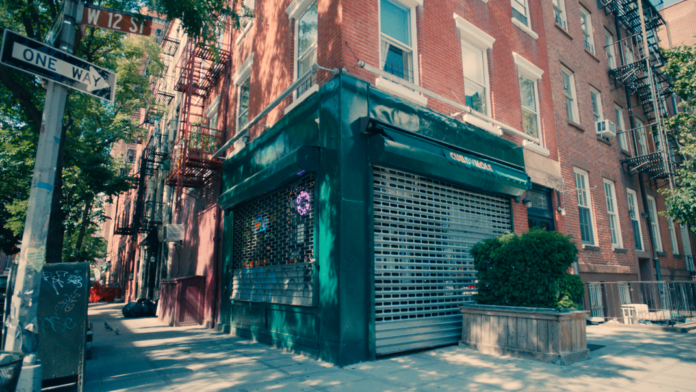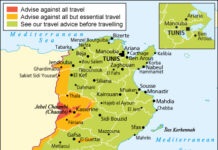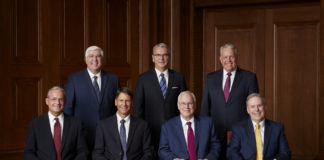SMITHSONIANMAG.COM | Jan. 21, 2021, 12:36 p.m.
Writer and social commentator Roxane Gay chuckled while describing her first visit to a lesbian bar—Panic Bar in Lincoln, Nebraska. “I was 21,” she says, “Maybe 20.” Gay describes the bar, which closed this fall, as a dive, and summed up why it was special: “It was just cool to go, and know that there were other lesbians in the world.”
Bar manager Jo McDaniel has similar reminiscence of Phase 1, an iconic lesbian bar in Washington D.C. ‘s Capitol Hill neighborhood that closed its doors permanently in 2016. “It was a force,” she says of the establishment that was once the longest operating lesbian bar in the country and where she tended bar. “Losing such an institution was incredibly difficult for D.C.” Upon learning of the bar’s unexpected closure, patrons expressed their shock on Facebook. “Wow! I thought that I would never see the day that Phase 1 would close down,” wrote one. Another declared, “There is no place left.”
D.C. is far from the only city to lose its beloved lesbian bars. Across the country, nightlife spaces dedicated to queer and gay women have been closing at a staggering rate over the past 30 years. (The Panic Bar shuttered for good in November after first closing temporarily due to the Covid-19 pandemic.) In the late 1980s, an estimated 200 lesbian bars existed in the United States. By 2019, researchers believed only 15 remained.

Gay, who lives in Los Angeles, says she doesn’t understand why there are so few bars—L.A.’s last one closed in 2013. “It doesn’t make sense that a city of this size, with a lesbian population that is significant, has no bars,” she says.
Despite their ever-decreasing numbers, lesbian bars still matter. More than a safe space for people of marginalized genders—including transgender and nonbinary people—to gather, these bars figure strongly into queer history. “They’re community centers, they’re fun places to meet other lesbians and/or bisexual women. And they can be sexy spaces,” says Gay. “I think that they’re vital.”
While numbers began dwindling before the pandemic began, owners and patrons of the remaining lesbian institutions are now even more worried for their futures as nightlife and service industries have been hit especially hard by regulations designed to minimize the spread of Covid-19. After initial closures, some bars were allowed to reopen over the summer, but most never returned to maximum capacity. The onset of winter and a second wave of infections have left watering holes in limbo. Some are closed again, others have seen reduced service hours and many are left to wonder how they’ll weather the cold months when outdoor service is difficult, if not impossible. These fears are compounded for lesbian bars, which cater to a more narrow demographic and take in less money, because women, trans people and nonbinary folks tend to have less “leisure dollars” due to pay inequity and discrimination. Shelley Brothers, who’s co-owned Seattle’s Wildrose for 20 of its 36 years, says they’re committed to fully reopening despite financial worry. She and her business partner took part-time jobs this year and, for the first time in two decades, were forced to lay off employees. In the spring, most of the remaining lesbian bars launched GoFundMe campaigns to help pay bills and support staff.
The idea of losing these bars catapulted two Brooklyn filmmakers into action. In October, Erica Rose and Elina Street launched the Lesbian Bar Project, a nationwide fundraising campaign to help the bars stay afloat through the pandemic. In total, the project’s month-long efforts raised $118,000, to be split evenly among 13 bars. (Texas’ two bars—Dallas’ Sue Ellen’s and Houston’s Pearl Bar—opted out of the donations to help the others.) Now, as they ride the second wave of Covid-19 infections, with reduced staff, reduced hours and newly implemented safety plans, the bars are thankful for the project’s aid. Money from the Lesbian Bar Project will go towards two months of rent for Denver’s Blush & Blu, which reopened earlier this month at 25 percent capacity.
Rose and Street first imagined the Lesbian Bar Project during New York’s stay-at-home order. Fueled by reports on the country’s declining lesbian bar scene, the city’s lockdown provided time to reflect on the importance of physical, queer gathering spaces. “When something is taken away from you, that’s when you realize you really do need it,” Street says. Rose and Street both credit New York’s Cubbyhole, an LGBTQ bar in the West Village, for helping them come out and find their community. “When I walked into Cubbyhole, I immediately felt this access and visibility to queer women being themselves. That was a wake-up call: This is who I am, and I have a space to do that,” Rose says. Ensuring others have the space to “actualize their feelings and live their queer authentic” lives has been her driving force in creating the Lesbian Bar Project.

Along with producers Lily Ali-Oshatz and Charles Hayes IV, actress Lea DeLaria of “Orange is the New Black,” and financial support from Jägermeister, the Lesbian Bar Project was born of a mission to celebrate, support and preserve the remaining bars. By fundraising and spreading awareness through a short PSA and their website, the project seeks to ensure these spaces “not only survive but thrive in a post-pandemic landscape.”
Rose and Street describe the support the project received as “humbling.” The work has launched the filmmakers on a longer journey to develop a docu-series, which they hope to release in 2022, on the importance of lesbian bars.
Women who are attracted to women have been gathering for centuries, but according to Katherine Ott, a curator at the Smithsonian’s National Museum of American History, America’s first lesbian bar remains unknown. “I don’t think anyone knows the first bar, and if they claim to know it, they’re lying,” says Ott.
Some historians credit San Francisco’s Mona’s 440 Club, which opened in 1936, as the first, but the blog Lost Womyn’s Space notes the 1933 repeal of Prohibition led to Chicago’s first lesbian and gay bars, so it’s possible Roselle Inn opened before Mona’s. According to Gwen Shockey, founder of the ADDRESSES PROJECT, which documents lesbian and queer women’s spaces in New York City, one of New York’s earliest “ladies bars” was Café Des Beaux Arts, active from 1911 to 1921. Shockey describes the establishment as a “meeting place for middle to upper class women,” who were likely white.

Ott suggests lesbian bars—or their prototypes—began even earlier, when cities enacted dress laws prohibiting people from wearing clothing of the opposite sex in public. Columbus, Ohio, instituted its ordinance in 1848; Memphis, Tennessee, did so in 1863. Growing in popularity over the 1860s, Ott says eventually 40 cities had anti-cross-dressing laws.
“[Bars] must have started when the cross-dressing laws and vice laws [legislation that criminalized “vices” such as prostitution, opiate use and polygamy] started,” explains Ott, as bars offered some semblance of safety.
Writer Joan Nestle, cofounder of the Lesbian Herstory Archives, insists, “from the 1920s on,” gathering places for queer women and men existed in America’s big cities. She entered New York’s Greenwich Village lesbian bar scene in the late 1950s, when most lesbian and gay bars were mafia-owned. “Organized crime, always interested in a quick, desperate buck, played an important role in keeping these bars open,” Nestle says. Bar owners frequently paid off police to keep the watering holes open, but raids were not uncommon.
Patrons were sometimes arrested for visiting “immoral” establishments or violating dress laws, notes a 2015 Vice article. This largely affected butch women and “passing women”—women who “lived, worked, dressed as men,” says Nestle, adding the term transgender men didn’t exist in lesbian communities until the 1970s. Because women could be arrested for wearing men’s clothing, Nestle recalled a young butch who sewed lace on her socks to decriminalize herself.
Black and Puerto Rican women attended New York’s downtown bars, and Nestle spoke of a thriving bar life for black gays, lesbians and passing folks in Harlem and Spanish Harlem from the 1930s to the 1950s. A 2019 thesis from architect Gwendolyn Stegall suggests Harlem’s LGBTQ scene of the era provided respite for black lesbians who were not always welcome in the Village.
Despite risks, lesbian bars became spaces for women to come out, find others and meet lovers. Desire lived in those bars, but so did community. “[They] were filled with the rituals of a despised people,” says Nestle, “who made the world they needed.”
As the gay rights movement gathered momentum following the 1969 Stonewall Riots, lesbian bars continued to evolve, solidifying their importance. They became places where organizers met and brainstormed, and the site of numerous fundraisers once AIDS gripped the gay community. “In-person gathering enabled our community to demonstrate and march and form the activist organizations that led to the Gay Rights Movement,” says Shockey.

Marlene Colburn, cofounder of New York’s Dyke March, remembers hosting recruitment parties for both the Lesbian Avengers and the Dyke March at various West Village lesbian bars, including Crazy Nanny’s (1991 to 2004), Cubbyhole (at its original location, where Henrietta Hudson now stands, 1983 to 1990), and Henrietta Hudson (opened in 1991).
“Every group I’ve ever been in would go [out after demonstrations],” remembers Maxine Wolfe, who helped start Act Up’s women’s committee, the Lesbian Avengers and the Dyke March. “There were restaurants and bars we went to, but mostly they were spaces where you could be who you are.”
Yet lesbian bars have never been perfect. Like the outside world, racism, transphobia and biphobia existed within, and many were inaccessible to disabled women. “So there was always tension,” Ott says. “The bars were never a really good solution to all of the discrimination and hate. Inside the bars, or inside the groups of women who went to the bars, was all the shit that was happening outside.”
Shockey agrees, noting that many of New York’s lesbian bars of the bygone era were not always accepting of queer women of color. And Wolfe described a practice known as “carding,” in which bars would only card women of color to exclude them. Colburn experienced something similar in the early 1980s, while trying to meet a date a Shescapes event—a lesbian bar party. She was barred from entry and told a private party was happening inside. Unable to contact her date, Colburn hung around. She saw white women admitted and women of color turned away. (A successful discrimination lawsuit was brought against Shescapes for denying black and brown people events admission in 1985.) Dress codes were another tool used by bars to prohibit entry to black and brown lesbians.
Lesbian bars have struggled to keep up with rapid societal changes, including greater LGBTQ acceptance, the internet and a more gender-fluid community. With dating apps and online communities, bars aren’t necessary for coming out and connecting with queer women. “There are so many different ways people socialize now that wasn’t possible [before],” Ott says. (Gay men’s bars have struggled with similar issues to a lesser degree.) Stegall’s thesis notes much of the queer community “claim that ‘lesbian’ leaves out bisexual women and trans people, who definitely have been historically (or even sometimes currently) shunned from the community.” Younger generations of queer women—including Rose and Street—have embraced a more inclusive community. They believe lesbian bars exist for people of all marginalized genders.
These factors, compounded by gentrification and income disparities between men and women, have largely contributed to declining bar numbers. Julie Mabry, owner of Pearl Bar, notes that, even before Covid-19, women had less disposable income, which means lesbian bars typically don’t ask for cover charges or provide bottle service, yet they pay the same increasingly high rents as gay and straight bars. Those same rising costs also push out residents who called those neighborhoods and bars home.

The Lexington Club, San Francisco’s cherished lesbian/queer bar closed in 2015 after nearly two decades due to the changing landscape of the city’s Mission District. Once home to working class Latino families and the “epicenter” for queer women in San Francisco, says former bar manager Benjamin McGrath, the neighborhood began attracting new residents during the tech boom of the mid-2000s. McGrath describes the neighborhood at the time as one of the fastest gentrifying areas in the city. Rents, for small local businesses and homes, skyrocketed. Despite being an internationally known bar that drew visitors from all over, McGrath says, “We paid the bills because of our regulars.” Regulars, that is, who could no longer afford to live in the Mission.
In October 2014, Lila Thirkield, owner of The Lexington Club, announced her decision to sell the bar, writing on Facebook: “Eighteen years ago I opened The Lex to create a space for the dykes, queers, artists, musicians and neighborhood folks who made up the community that surrounded it. Eighteen years later, I find myself struggling to run a neighborhood dyke bar in a neighborhood that has dramatically changed.”

The decline in bars has not meant an end to queer nightlife. Across the country, pop-up parties and monthly events for lesbians and queers were thriving before Covid-19 and will likely continue in the pandemic’s wake. As for whether the bars are worth saving, most agree they are. But Nestle insists it’s up to younger women, who make up a major swath of the bars’ clientele, to decide.
McDaniel, missing the Phase 1 community in D.C., helped open A League of Her Own, a new queer bar in the city’s Adams Morgan neighborhood, in 2018, with owner Dave Perruzza. The bar is located in the basement of Pitchers, Perruzza’s gay sports bar.
“D.C. can be a lonely city, so providing a place where you know you can find your people is absolutely our mission,” says McDaniel. “Space like this is necessary for a community to connect and thrive. I’m just grateful we’ve been able to find more ways to provide that, even in uncertain times.”








